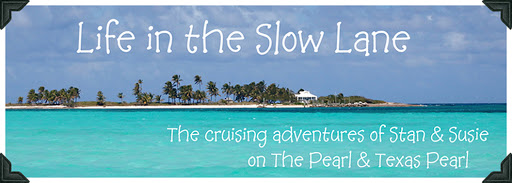Basin Harbor Club Mooring
Today was another short cruise...down the Otter River and into Mile Bay. Mile Bay is on the Vermont side of the lake, but we cruised by the Palisades on the New York side before stopping for the day. The Palisades are magnificent cliffs that rise 100' above the water and plunge another 140' beneath the water's surface. The water is so deep you can take your boat right up to the wall. The lake is much narrower here, so getting from one side to the other doesn't take long.
We stopped in Mile Bay so we could visit the Lake Champlain Maritime Museum. Basin Harbor Club will let you use one of their mooring balls while you go ashore to the Museum. We were told at the museum no one monitors the moorings and we could spend the night...so we did. Ever since Samuel de Champlain stumbled through the Green Mountains in 1609, Lake Champlain has been one of the most important, and fought for, waterways in the Northeast. Wedged between New York, Vermont, and Canada, the lake has hosted bloody battles and bootlegging operations, plus the gamut of shipboard shenanigans. The Lake Champlain Maritime Museum reveals the history of this contested body of water. Along with the history of Lake Champlain they have displays of antique boats, rowboats, canoes, motors, and replicas of Benedict Arnold’s gunboat, and a sailing canal schooner. It was all very interesting and a great way to spend the afternoon.
Later in the day we took the dinghy and explored Basin Harbor and Button Bay. The Basin Harbor Club is a 700-acre resort with cottages overlooking the lake. It has provided swimming, boating, golf, tennis and gourmet dining to its guests for over 100 years. It looked like a nice place to spend a week or two.
The Palisades
Iceboats can go up to five times the speed of the wind because of their minimal surface drag. In 1907 an iceboat was clocked traveling at 144 MPH. For decades iceboats were the fastest vehicles on earth. They were originally used for commercial purposes along the Hudson and Lake Champlain, but by the 1860 they were becoming a sport.
Benedict Arnolds’ Gunboat Philadelphia was built in 1776; it was sunk in Lake Champlain during a naval battle with the British in the same year. It was salvaged off of Valcour Island in 1935 and is the oldest surviving American fighting vessel. We were able to see it last summer at the Smithsonian Museum in Washington DC. This is the Philadelphia II, a full sized replica of the original ship. It's located at the Lake Champlain Maritime Museum.









No comments:
Post a Comment